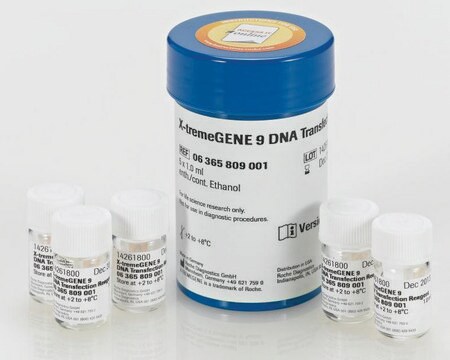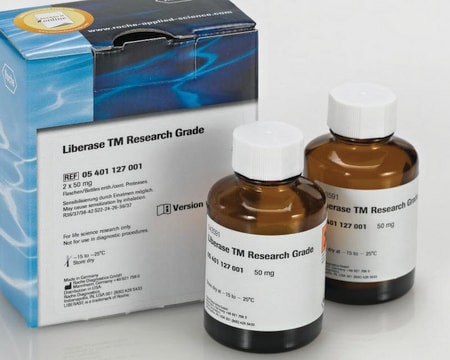Key Documents
CAPHOS
Calcium Phosphate Transfection Kit
Most cost effective transfection reagent kit for transient and stable transfection of DNA into mammalian cells
Synonim(y):
Gene delivery
About This Item
Polecane produkty
klasa czystości
for molecular biology
Poziom jakości
Postać
solution
zastosowanie
kit sufficient for 160 transfections (6 cm dishes)
kit sufficient for 400 transfections (3.5 cm dishes)
kit sufficient for 80 transfections (10 cm dishes)
metody
transfection: suitable
Warunki transportu
dry ice
temp. przechowywania
−20°C
Opis ogólny
Zastosowanie
- to enable transfection
- to transfect Hek293T cells
- to transfect H29D cells
BAEC
Bowels melanoma cells
CHO K1
COS-7
Fibroblasts (human embryonic, neo derm)
HEK293
Huh 7
IMR-90
LLC (Lewis Lung Carcinoma)
NIH3T3
PC-12
PCI-13
SH-Sy5Y
SK-Hep-1
T47D
Cechy i korzyści
- Suitable for transient and stable transfection
- Reproducible for a wide range of cell types
- Widely referenced
- Inexpensive
Komponenty
5 ml 2.5M CaCl2 (C2052)
25 ml 2x HEPES Buffered Saline (H1012)
25 ml molecular biology grade water (W4502)
Zasada
Inne uwagi
produkt powiązany
Hasło ostrzegawcze
Warning
Zwroty wskazujące rodzaj zagrożenia
Zwroty wskazujące środki ostrożności
Klasyfikacja zagrożeń
Eye Irrit. 2
Kod klasy składowania
12 - Non Combustible Liquids
Temperatura zapłonu (°F)
Not applicable
Temperatura zapłonu (°C)
Not applicable
Certyfikaty analizy (CoA)
Poszukaj Certyfikaty analizy (CoA), wpisując numer partii/serii produktów. Numery serii i partii można znaleźć na etykiecie produktu po słowach „seria” lub „partia”.
Masz już ten produkt?
Dokumenty związane z niedawno zakupionymi produktami zostały zamieszczone w Bibliotece dokumentów.
Klienci oglądali również te produkty
Produkty
Transfekcja wprowadza materiał genetyczny do komórek, wspomagając badania nad ekspresją genów i biologią komórek.
Transfection is the introduction of DNA, RNA, or proteins into eukaryotic cells and is used in research to study and modulate gene expression. Thus, transfection techniques and protocols serve as an analytical tool that facilitates the characterization of genetic functions, protein synthesis, cell growth and development.
This brief webinar provides an overview of what transfection is and the methods that are used to introduce DNA or RNA into eukaryotic cells.
Protokoły
Inkorporacja DNA do komórek eukariotycznych przy użyciu fosforanu wapnia jest powszechną metodą transfekcji. Ten protokół transfekcji może być zoptymalizowany dla wielu różnych typów komórek.
Calcium Phosphate Transfection Kit Protocol
Nasz zespół naukowców ma doświadczenie we wszystkich obszarach badań, w tym w naukach przyrodniczych, materiałoznawstwie, syntezie chemicznej, chromatografii, analityce i wielu innych dziedzinach.
Skontaktuj się z zespołem ds. pomocy technicznej













